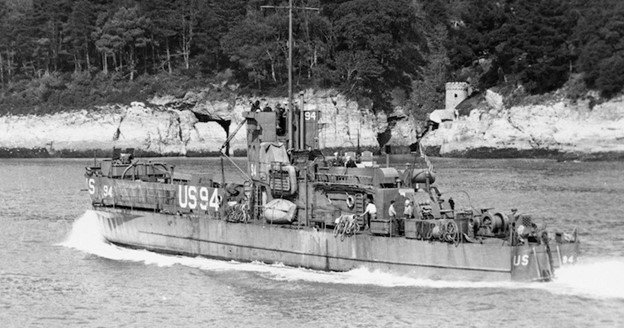
Eighty years ago, on June 6, 1944, Allied troops stormed the beaches of Normandy, France, in what was the largest amphibious invasion of World War II. Among some 800,000 troops was a small, Coast Guard-manned flotilla of 24 ships, landing on Omaha and Utah Beaches—all commanded by Captain Miles Imlay, who had been in the Coast Guard since 1923. Out of some 800 Coast Guardsmen who participated in the battle, 15 lost their lives that day.
Among those 15 Coast Guardsmen killed in action at Normandy was 21-year-old John “Jack” Albert DeNunzio. His final breath would be forever recorded for posterity by a Coast Guard photographer and a world-renowned Life Magazine combat photographer.
Early Years
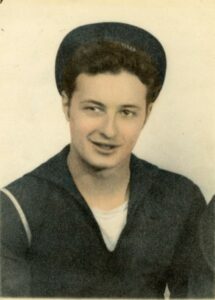
Jack was born on July 17, 1925, in Summit, New Jersey, and raised there. He was a second-generation Italian American, as his grandfather had arrived in the United States from Italy in 1892. His father, John, was an electrician for the Jersey Central Power & Light Company. Jack excelled at long distance swimming and attended Summit High School. Prior to enlisting, he worked as a plumber’s helper and a flower truck driver.
War Service
The United States declared war on Germany after Pearl Harbor, Hawaii, was attacked on Dec. 7, 1941. Sixteen-year-old DeNunzio was eager to enlist to do his part in the war, but his parents would not allow it. A year later, on Dec. 12, 1942, DeNunzio left high school in his junior year and enlisted in the U.S. Coast Guard, with his father’s consent, as an apprentice seaman for a three-year period. After a period of training in New York City, on Feb. 9, 1944, he was assigned to the LCI (L) 94. Short for Landing Craft Infantry, this LCI would be the only ship DeNunzio would serve on during his Coast Guard career.
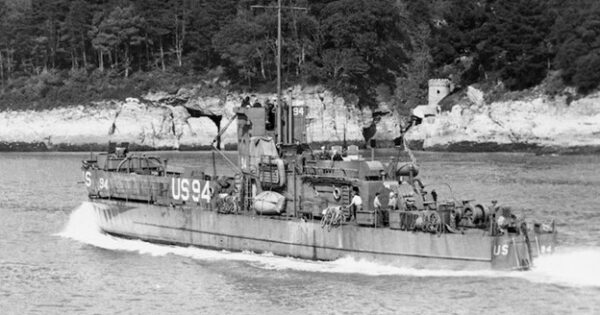
DeNunzio’s LCI was assigned to Coast Guard-manned Flotilla Four. The flotilla originated in Galveston, Texas, and its 24 vessels cruised through the Gulf of Mexico, with stops at Key West; Norfolk, Virginia; Bermuda; Monaco, and Bizerte, Tunisia. On July 10, 1943, the flotilla participated in the landings at Sicily, whose capture would allow the Allies to invade mainland Italy. On September 9, 1943, Flotilla Four participated in the Battle of Salerno, Italy. DeNunzio saw all of this action firsthand from the 94.
After the Italian landings, Flotilla Four steamed for England. On arrival, the LCIs were split up with one group sent to Saltash, up the river from Plymouth, and another group went to Falmouth. A third group, manned by Navy personnel, was added shortly after the flotilla arrived.
DeNunzio in the Service
DeNunzio loved every moment of the service. In fact, he referred to his shipmates as “one big happy family.” He wrote to his father on Feb. 27, 1944:
“I don’t know how to put this, Dad, but I am really happy over here. It may seem incredible for anyone to say that while they are overseas, especially the outfit I am in. I guess it may be the fellows around me, they are tops. We almost represent each state in the union; I am the only one from Jersey.”
In letters to his mother Theresa, who he called “Beautiful,” “Darling,” “Honey,” and “Mom,” DeNunzio mentioned how much he enjoyed the service and being overseas. In a May 27, 1944, letter to his mother, DeNunzio mentioned that he “went swimming the other day for my first overseas dip, and, Mom, was it cold. I have been in plenty of cold water, but this topped it all; was I shocked to find out how cold it was.”
DeNunzio and his shipmates knew the invasion was coming. However, no one, not even the LCI captains or the group commanders, knew the exact date. It was common practice among sailors to participate in a betting pool on the invasion date. In preparation for the invasion, DeNunzio’s LCI flotilla participated in practice landings at Slapton Sands, off the southwest coast of England. During once such practice, German torpedo boats evaded Allied vessels protecting the landing fleet, torpedoed two LSTs and killed 700 soldiers and sailors.
Beginning in late May 1944, the military vessels were cordoned off. Crews were confined to their ships, and no one could leave or speak even with seamen on other ships, except for official business. The flotilla was redesignated Flotilla 10, and 15-pound canvas bags marked “Top Secret” were hauled aboard each of the flotilla’s 24 LCIs, with orders not to open until further notice. One bundle of orders from these bags was three inches thick, containing concise plans for D-Day with charts, maps, and photographs of the beaches.
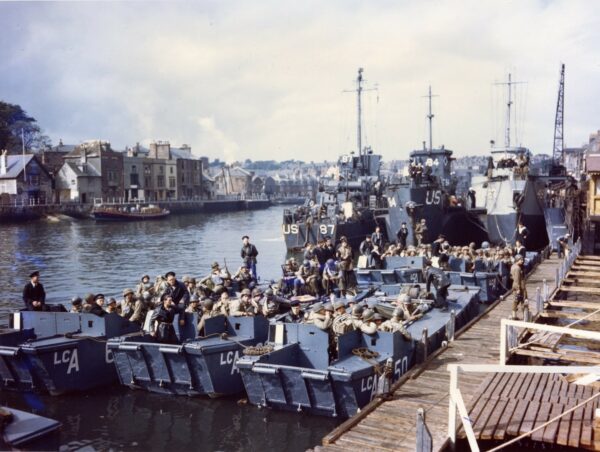
Living in cramped quarters and not knowing any information about the forthcoming invasion, tensions ran high among the crew. Just before the ships were sealed, the 94’s captain, 27-year-old Gene Gislason, allowed his crew to purchase liquor for a party. He was a rather unorthodox captain who preferred his own rules. According to the memoirs of another crew member, Charles Jarreau, the party “. . . started at 0700 and, boy, at the end of the day, everybody was just crapped out, but it sure relieved the tension. After a night’s sleep, we sobered up and started taking troops on board.” It is likely that some of DeNunzio’s last hours were spent enjoying this shipboard party.
In his final letter to his mother, dated June 3, 1944—just three days before Normandy—DeNunzio enclosed a group photo of the entire crew of the 94 taken on June 1st. The ship’s crew signed their names on the back of the picture. They had just learned of the coming invasion from an announcement read at Morning Colors that day. Perhaps this is why the crew decided to pose for the picture. The photo was distributed among the crew on June 2, and troops boarded the 94 the next day. The crew soon learned the details of the invasion during a June 5 meeting on board, where panoramic photographs of the beaches were laid out for all to see, and everyone’s serial numbers and beneficiaries were double checked. The crew learned of the enormous scale of the invasion and the fact that the latest weaponry would likely be used against the landing forces.
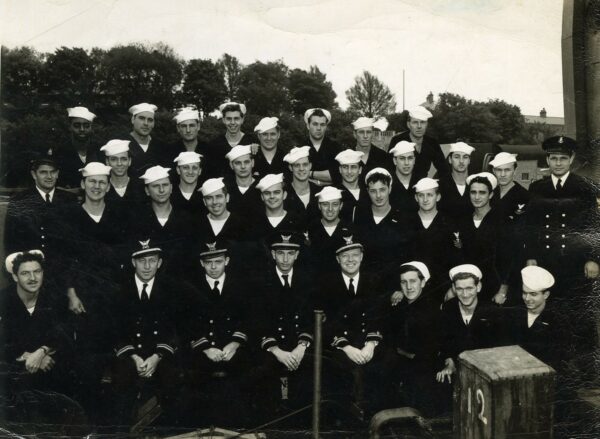
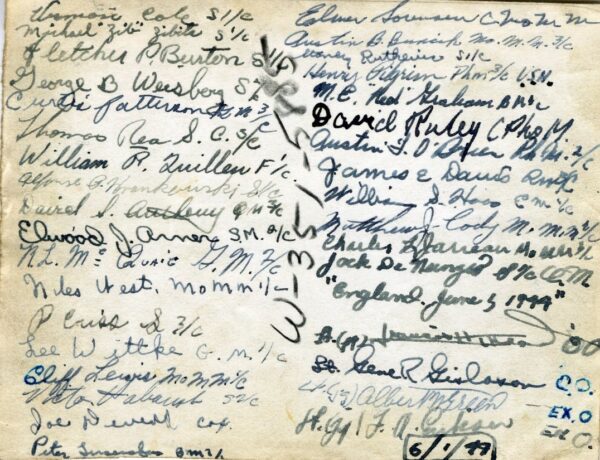
In the photo was one of DeNunzio’s closest friends, Thomas Rea, from Brooklyn, New York, and the only other Italian American seaman on the 94. He is pictured behind DeNunzio’s right shoulder. The Black seaman in the upper left of the photo is Plant Criss, of Oakland, California, who DeNunzio described as “a really swell fellow.” And the seaman behind DeNunzio’s left shoulder is David Anthony of San Antonio, Texas. Moments after he finished his last letter to his mother, he bumped into an old friend from home, and added a postscript describing the chance meeting.
Read the complete letter
-
June 3, 1944
England
My Darling Mother;
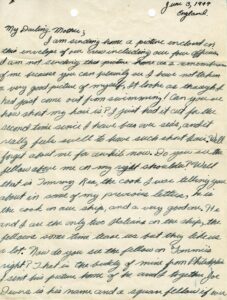
Jack DeNunzio’s three-page letter written to his mother just days before his passing on D-Day. I am sending home a picture enclosed in this envelope of our crew including our four officers. I am not sending this picture home as a remembrance of me because you can plainly see I have not taken a very good picture of myself. It looks as though I had just come out from swimming! Can you see how short my hair is? I just had it cut for the second time since I have been overseas, and it really feels swell to have such short hair. Well forget about me for a while now. Do you see the fellow above me on my right shoulder? Well that is Tommy Rea, the cook I was telling you about in some of my previous letters, he is the cook on our ship, and a very good one. He and I are the only two Italians on the ship. The fellows some time tease us but they like us a lot. Now do you see the fellow on Tommie’s right? That is the buddy of mine from Philadelphia. I sent his picture home of he and I together, Joe Devers is his name and a square fellow if ever
-
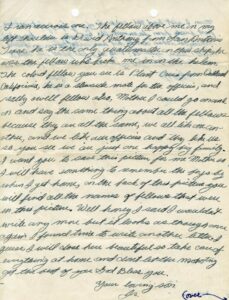
Jack DeNunzio’s three-page letter written to his mother just days before his passing on D-Day. I ran across one. The fellow above me on my left shoulder is David Anthony from San Antonio Texas, he is the only quartermaster on this ship, he was the fellow who broke me in on the helem [sic]. The colored fellow you see is Plant Criss from Oakland California, he is a stewards mate for the officers and really swell fellow also. Mother I could go on and on and say the same thing about all the fellows because they are all the same. We all like one another, and we like our officers and they like us so you can see we are just one happy big family. I want you to save this picture for me Mother so I will have something to remember the boys by when I get home. On the back of this picture you will find all the names of fellows that were in this picture. Well honey I said I wouldn’t write any more but it looks as though once again I found time to write another letter. I guess I will close here beautiful so take care of everything at home and don’t let the monotony get the best of you God Bless You.
Your loving son,
Jr.
-
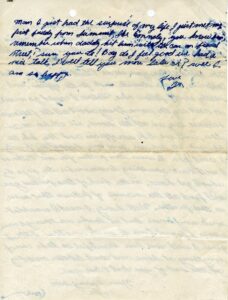
Jack DeNunzio’s three-page letter written to his mother just days before his passing on D-Day. Mom, I just had the surprise of my life. I just met my first buddy from Summit, Ike Connolly. You know him, remember when Daddy hit him with the car on F____ Street, sure you do! Boy do I feel good, we had a nice talk. I will tell you more later, ok? Well, I am so happy.
Love,
Jr.
Final Moments
The 94 came alive at 4 a.m. on June 6. Troops and equipment were already on the beaches. Flotilla 10 delivered troops and supplies to Omaha and Utah Beaches; men had to wade through water and avoid mines on the beaches. Captain Gislason was scheduled to land on the beaches simultaneously with two other LCIs, but he changed course at the last minute when it became clear he was steering straight into enemy fire.
Around 8:50 a.m., the 94 had just finished unloading troops and medical supplies and was withdrawing from the beach when it was hit by a barrage of mortar shells. DeNunzio was in the pilot house with two shipmates when the barrage struck, and all three men were hit. DeNunzio lost both of his legs and part of his stomach. Two other men were wounded including Anthony, who was hit with shrapnel in both legs and feet but survived.
LCI-94’s combat photographer, David Ruley, of Pensacola, Florida, had been filming color footage of the invasion. He witnessed the attack on the 94 and the chaos that ensued. The 94 also carried famed Life Magazine photographer Robert Capa on special assignment for the magazine.
The 94’s medics immediately gave blood plasma to DeNunzio and tried to make him as comfortable as they could. It was a horrific scene no one on the 94 would ever forget. Even Capt. Gislason watched in shock with blood and flesh splattered over his uniform and the ship. Ruley turned his camera to DeNunzio and filmed his final moments, while Capa snapped a photograph of the scene at a similar angle. DeNunzio died just 15 minutes after being hit. Ruley’s film footage is now at the National Archives, while Capa’s photo was published in the June 19, 1944, issue of Life Magazine.
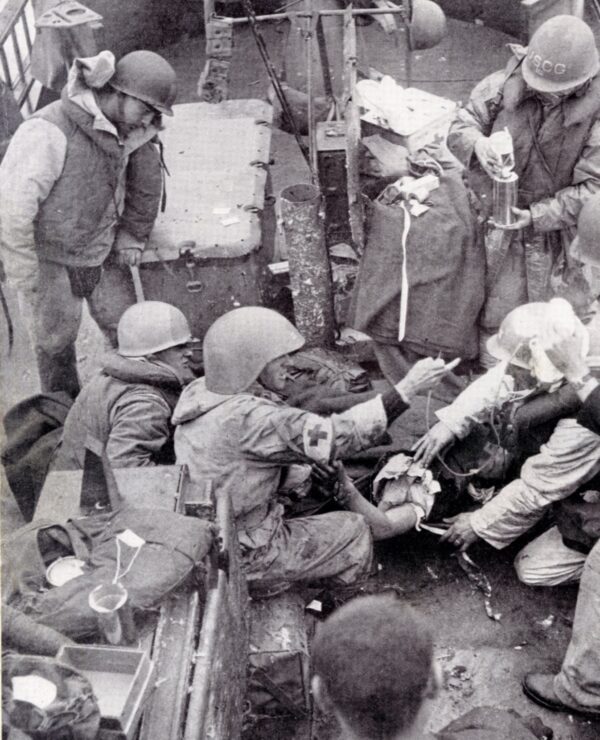
Two of DeNunzio’s shipmates in the pilothouse also died—23-year-old August Buncik, from Chicago, and 21-year-old Fletcher Burton of Providence, Rhode Island. Their bodies, along with DeNunzio’s, were delivered to a Coast Guard attack transport, USS Samuel Chase, but were later interred back on shore.
Over a month later, in the evening of July 26, 1944, four of the 94’s surviving crew—Plant Criss, James Davis, Clifford Lewis, and William Quillen—went ashore to visit the graves of DeNunzio, Buncik, and Burton. Their fallen shipmates were interred at a cemetery located about a mile inland from the beach and overlooking a pleasant green valley. White crosses were lined up neatly, with a flagpole and a mast from an unknown ship in the center. Flowers were planted around the crosses.
Family Reaction
Fourteen-year-old Dorothy DeNunzio sat at her desk on July 7, 1944, worried about her brother. The family had not heard from him for a while, so she wrote him a letter:
Your birthday is coming soon and we here at home would love to celebrate it, but there is a war on and things like that will have to wait…but we haven’t heard from you, and we are getting worried so let’s hear from you and know you are safe and sound. Well, may God be with you and keep you from harm.
Four days later, on July 11, the family was enjoying a pleasant afternoon on the porch at home. The elder DeNunzio was home from work on his lunch break. A Coast Guard vehicle pulled into the driveway. Instinctively, the family knew it was not good news. Two men, including one who had served with DeNunzio, stepped out of the car, and informed the family of his death. It fell on Dorothy to comfort her family as best as she could. Upon learning of his death, DeNunzio’s steady girlfriend vowed never to marry, even though Jack’s mother told her it was okay to marry someone else. True to her word, the girlfriend, who is never named in DeNunzio’s letters, never married.
The letter Dorothy DeNunzio had written to Jack was eventually returned. It is now part of the Jack DeNunzio Papers at the Coast Guard Office of Heritage, which Dorothy donated in 2016.
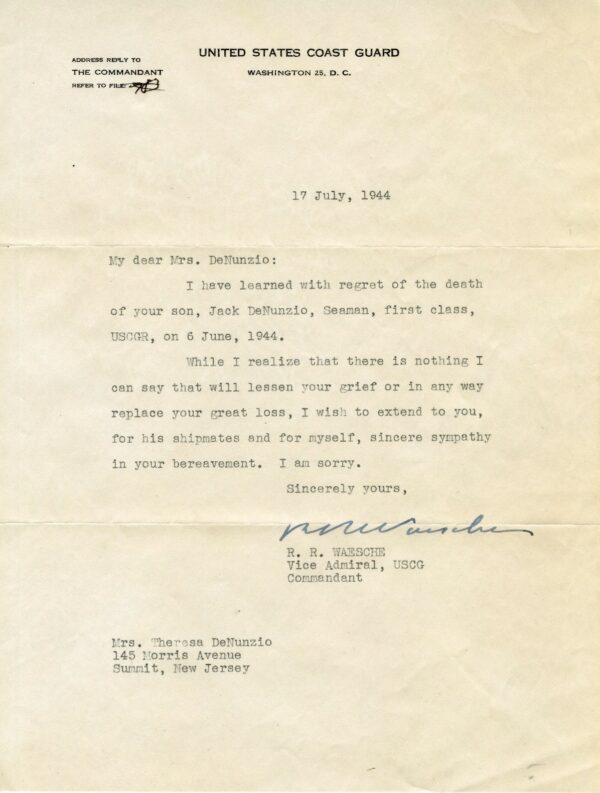
Conclusion
For his actions during World War II, DeNunzio was posthumously awarded the Purple Heart, American Campaign, and European-African-Middle Eastern Campaign medals. He and his fellow crewmen were interred at the Normandy American Cemetery at Colleville-sur-Mer, France. DeNunzio had enlisted in the United States Coast Guard a boy, wanting to fight for his country, and died a man.
The Fifteen Coast Guardsmen Killed in Action at Normandy on June 6, 1944
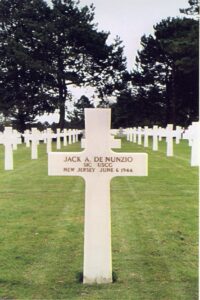
DeNunzio and 14 other Coast Guardsmen selflessly gave their lives at Normandy for the greater goal of world peace. For their actions and ultimate sacrifice, they were awarded the Purple Heart Medal.
- Stoy Kay Alexander, 18, Alta Vista, Kansas
- James Everett Atterberry, 23, Sebastian, Arkansas
- August “Austin” Bob Buncik, 23, Chicago, Illinois
- Fletcher Payne Burton, Jr., 21, Providence, Rhode Island
- John “Jack” Albert DeNunzio, 21, Summit, New Jersey
- Richard Irvin Frere, 18, Washington, District of Columbia
- Leslie Wayne Fritz, 23, Staten Island, New York
- Stanley August Glowacki, 27, Minneapolis, Minnesota
- Ernest Johnson, 27, Benton, Illinois
- Warren Joseph Moran, 23, New Orleans, Louisiana
- John “Jack” Edward Rowe, 21, Cranston, Rhode Island
- Harry Louis Siebert, Jr., 26, Glen Arbor, Michigan
- Rocco Simone, 22, Greensburg, Pennsylvania
- Stanley Valentine Wilczak, 25, Chicago, Illinois
- Bernard Lazarus Wolfe, 23, Newark, New Jersey
National Coast Guard Museum insider tip: Visitors will have the opportunity to learn more about the Coast Guard’s amphibious operations across North Africa, the Mediterranean and Europe in the WW2 Exhibit on Deck03 of the Museum.
